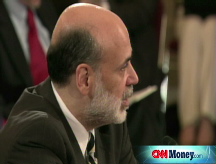Fed leaves rates unchanged
Central bank keeps key short-term rate at 2% and hints that it could stay there for a while as Ben Bernanke and Co. cite risks of inflation and a slowdown.
NEW YORK (CNNMoney.com) -- The Federal Reserve left a key short-term interest rate unchanged Tuesday and cited both the risk of a slowing economy and inflation pressures, a sign that the central bank may keep rates steady for the next few months.
The move was widely expected and cheered on Wall Street. Stocks were already trading higher before the Fed's mid-afternoon announcement due to lower oil prices and rallied further following the Fed's decision.
It is the second straight meeting that policymakers at the Fed held the so-called fed funds rate at 2%, following seven straight cuts from last September through this April.
The fed funds rate is an overnight bank lending rate used as a benchmark for many types of consumer loans as well as certain business loans.
The Fed generally cuts rates when it sees a risk of an economic slowdown and wants to spur spending by consumers and businesses. It typically raises rates when it is more concerned about fighting inflation.
But this year, the Fed has found itself having to worry about both a weak economy due to the housing slump and credit crisis as well as inflation pressures brought about by high prices for commodities such as food and oil.
"Although downside risks to growth remain, the upside risks to inflation are also of significant concern to the committee," the Fed said in a statement.
The Fed warned that the inflation outlook remains "highly uncertain" but also indicated that problems in the credit and housing markets, as well as high energy prices, are likely to hurt economic growth over the new few quarters.
The Fed also dropped language that it used in its last statement about downside risks to the economy. In June, the Fed said those risks "appear to have diminished somewhat."
Some economists saw the absence of that phrase in Tuesday's statement as a sign that the central bank is growing more concerned about a deeper-than-expected recession.
Keith Hembre, chief economist with First American Funds, said that the Fed may even consider cutting rates again soon, especially if oil prices keep falling.
"I think by the time we get to the end of this year or early next year, the inflation numbers will look a lot less threatening and I don't think the growth environment will be significantly improved," he said.
But Bernard Baumohl, executive director of The Economic Outlook Group, said he thinks the Fed is still more concerned with inflation than with the economy.
Baumohl said the central bank's policy group has too many so-called inflation hawks, those who worry primarily about price pressures, to allow the Fed to consider another rate cut unless the economy makes a very sharp downturn.
"I found this to be a poorly disguised compromise between those who believe inflation pressures are coming down and inflation hawks who fear the Fed is already behind the curve," he said.
To that end, Dallas Fed President Richard Fisher voted against the decision to leave rates unchanged, preferring instead to raise rates immediately. Fisher is widely regarded by Fed watchers as the most hawkish on inflation of the current Fed policy committee members.
Still, many economists believe the Fed won't move rates in either direction until after the presidential election. The Fed's next scheduled meeting is Sept. 16. After that, it has a two-day meeting in late October and one more meeting in December.
And barring a major economic disaster, such as another big bank failure, Rich Yamarone, director of economic research at Argus Research, said the Fed will keep rates at 2% until at least December, if not early next year.
"The Fed should be in a holding pattern for the next five months," Yamarone said, adding that unless a major bank goes under, he thinks the Fed's next move will be to eventually raise rates. ![]()



